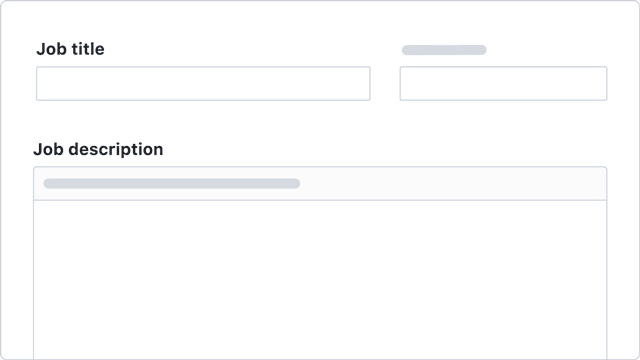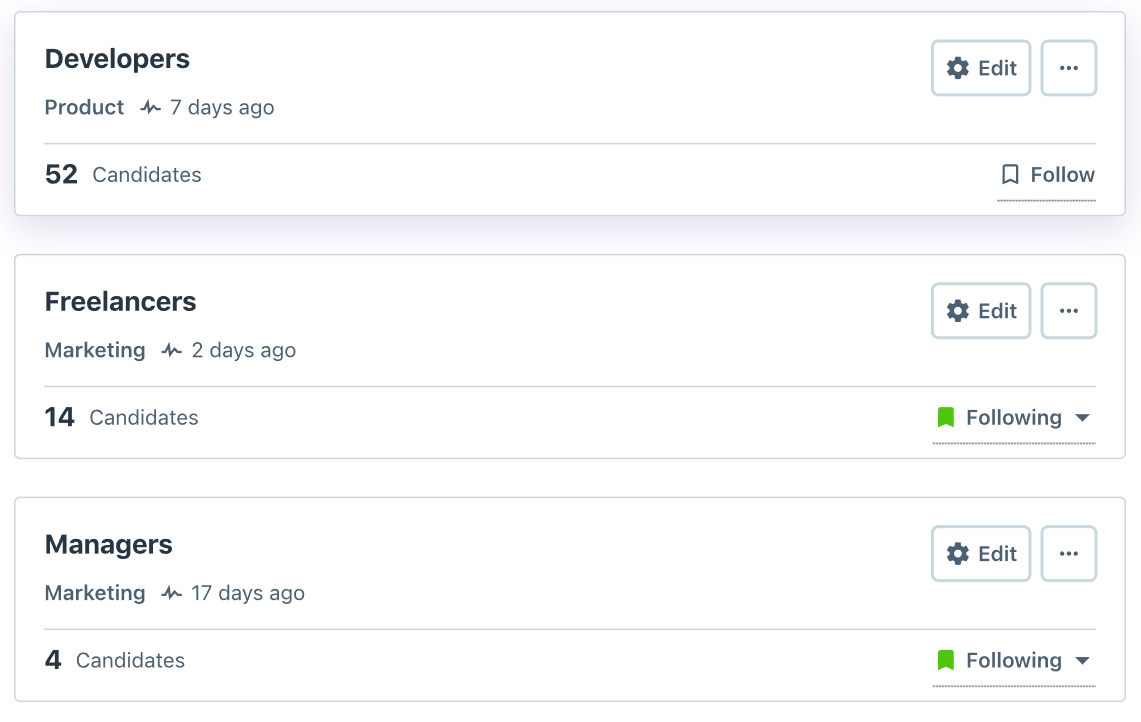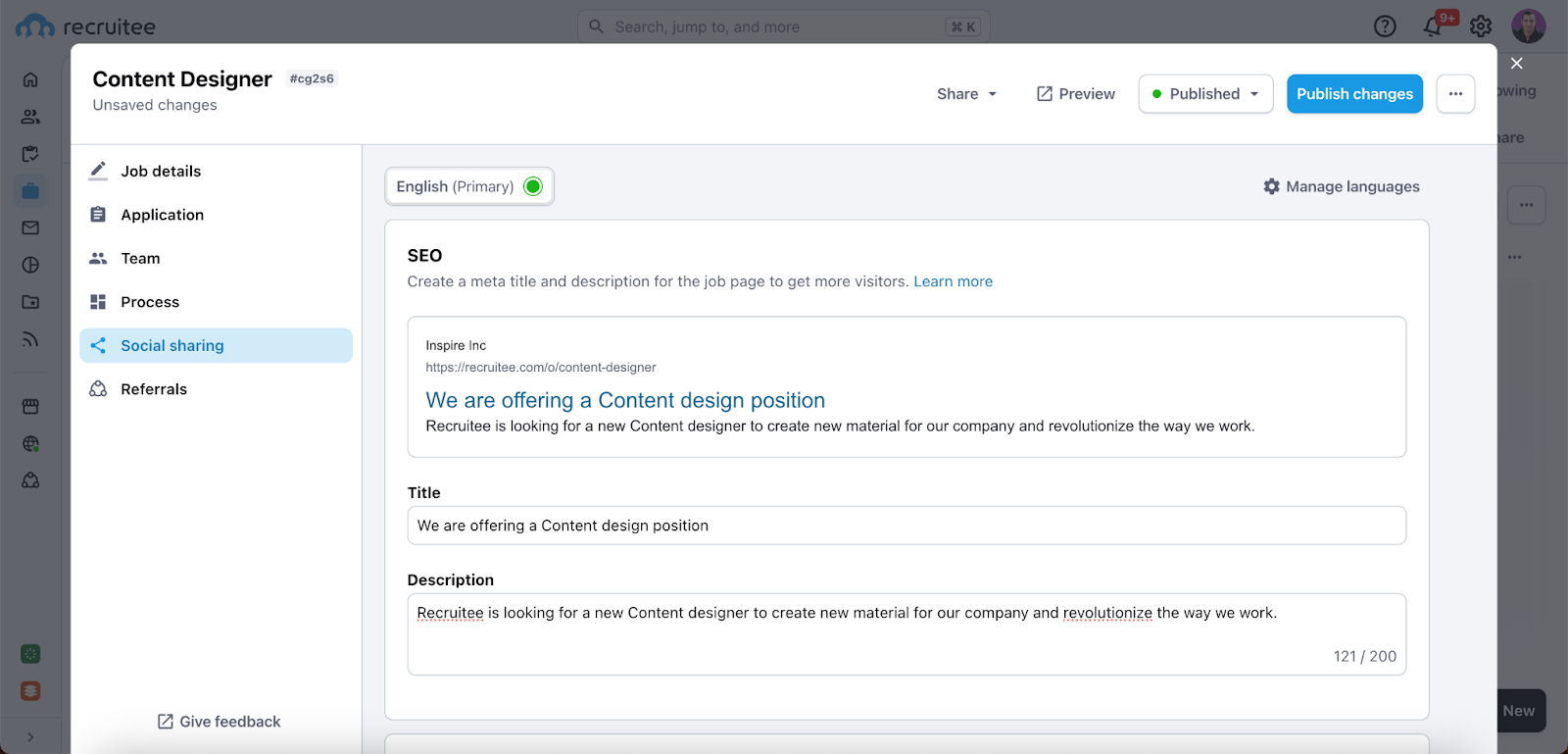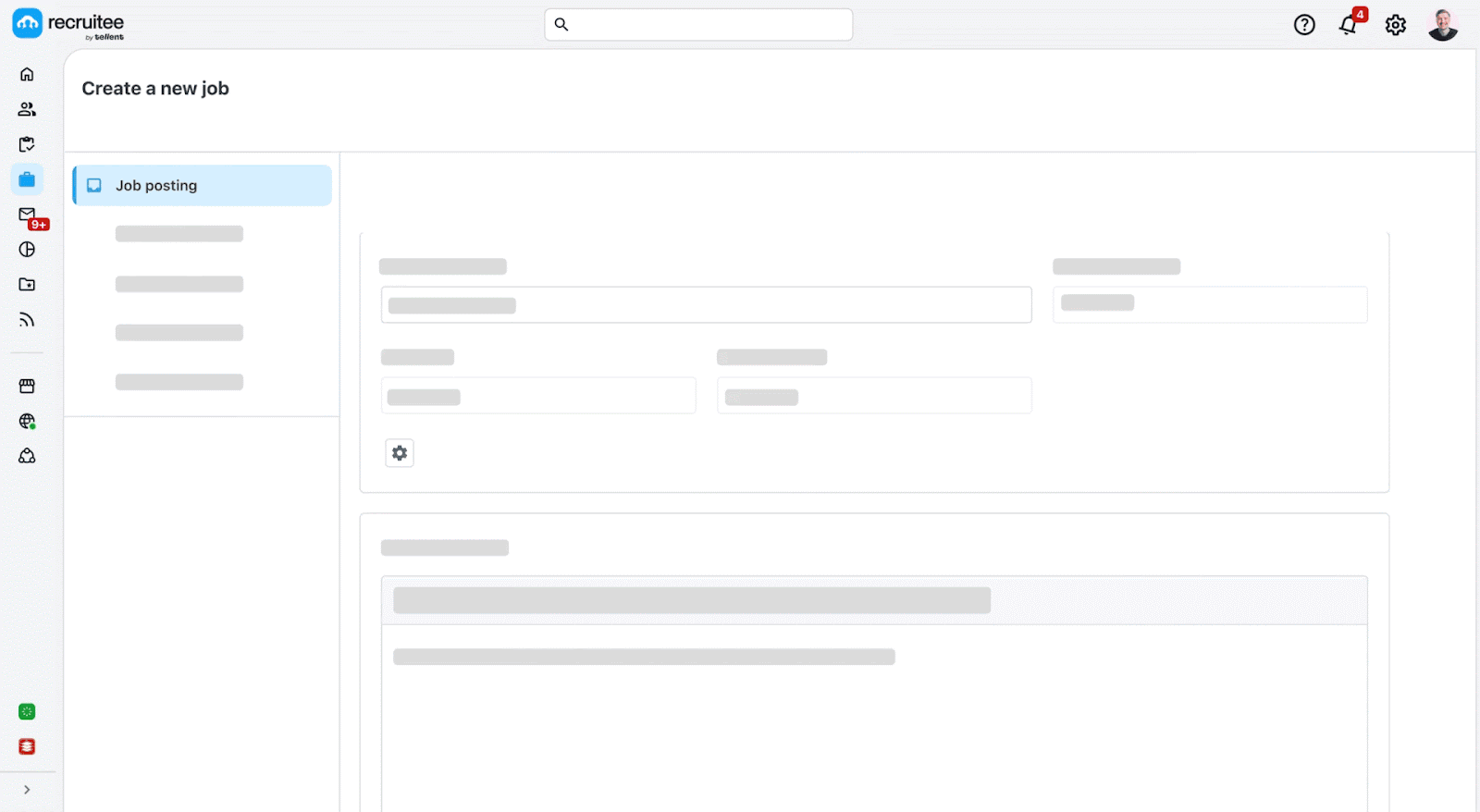A recruiter’s job is never done. They must constantly find and experiment with new ways to source and attract new talent for their organization. Job seeker habits are constantly shifting, driven by market changes, shifting workforce demographics, and skills gaps that wax and wane as new technologies emerge and grow.
Talent sourcing strategies must be just as flexible in this environment, evolving and shifting with the job market. Some sourcing techniques remain viable, while new ones are introduced regularly.
This guide will walk you through 22 talent sourcing strategies that companies should consider in 2025.
What is a talent sourcing strategy?
A talent sourcing strategy is a proactive approach used by recruiters and hiring managers to identify, engage, and attract qualified candidates for current or future job openings.
It involves using a variety of methods and tools—such as social media outreach, job boards, employee referrals, and talent databases—to build a pipeline of potential candidates.
A well-crafted sourcing strategy focuses on finding both active job seekers and passive candidates who may not be actively looking for a job but are open to opportunities.
Why is having a talent sourcing strategy important?
The talent landscape is evolving, with 70% of the global workforce not actively seeking new jobs, yet open to the right opportunities. Many highly skilled workers, likewise, are also opting for gig, freelance or fractional work, which has increasingly shrunk the talent pool for in-demand skill sets.
For recruiters, this means relying on traditional methods like job postings isn’t enough. They need to start thinking outside of the box, and become more deliberate and structured with their talent sourcing activities.
87% of companies worldwide report facing significant skills gaps, and many expect these gaps to persist over the next five years. The pressure is mounting to find candidates with specialized skills in a shrinking pool of available talent.
A proactive talent sourcing strategy helps recruiters overcome these challenges by allowing them to reach passive candidates, fill critical skills gaps, and maintain a constant flow of qualified talent. By staying ahead of the curve, recruiters can reduce time-to-hire, improve the quality of their hires, and ensure their organizations are equipped to meet current and future demands. Today, more than ever, talent sourcing must be agile and strategic to stay competitive in a tight job market.
7 reasons candidate sourcing strategies fail
There are more opportunities, channels, and tools than ever before to help with candidate sourcing. Still, sourcing the right candidates is no easy feat. Faltering early in the process can point your efforts in the wrong direction, and using the wrong tools can make managing inbound applicants a nightmare.
Understanding where candidate sourcing might go wrong is the first—and most important—step to mitigating these challenges.
To help, here are seven common reasons that candidate sourcing strategies fail:
- Lack of alignment with business needs. Different departments have different needs. Recruitment priorities and, by association sourcing strategies, should align with the company's overall direction to ensure you’re sourcing the right talent for broader business goals.
- Unclear recruitment objectives. Without clear objectives, it’s impossible to measure success. Defining goals allows for more precise sourcing strategies that target specific skills, roles, and departments.
- Weak partnerships between hiring managers and recruiters. Tensions arise when hiring managers don’t communicate their needs effectively, leading to frustration. Building strong partnerships from the start, through regular collaboration and clear role definitions, leads to better outcomes.
- Ineffective use of online platforms. Each role may require different sourcing channels. If you aren’t strategic about which platforms you use to find candidates, you’ll miss out on top talent. Understanding the candidate persona and matching it with the right sourcing tools is critical.
- Poor communication. Tailoring your job ads and communication style to suit the target audience (e.g., creatives vs. finance professionals) ensures better engagement. It’s also essential to avoid biased language that could alienate diverse candidates.
- Misuse of social media. Social media should build your employer brand, not act as just another job board. Consistently engage with your followers and share authentic content to build connections and expand your talent pool.
- Failure to nurture your talent pool. Developing a talent pool requires more than just collecting resumes. Regular engagement through content sharing and direct communication helps keep your talent pool active and responsive for future recruitment needs.
Now that we’ve explored some reasons why you may be failing at talent sourcing, let’s jump into how you can improve your talent sourcing strategy moving forward.
22 talent sourcing strategies for 2025
Talent sourcing techniques and strategies evolve rapidly, driven by new tools, shifting workforce demographics, and evolving expectations amongst candidates. Some sourcing techniques are still valid, while others are emerging thanks to the introduction of advanced AI and automation tools.
Here is a round up of 22 essential talent sourcing strategies for 2025.
1. Craft your candidate persona and job requirements
A well-defined candidate persona helps recruiters target the right talent by outlining ideal qualifications, skills, and cultural fit for each role.
This initial step involves close collaboration with hiring managers to ensure that job requirements are clear and realistic. It sets the foundation for all future sourcing efforts, ensuring the right candidates are identified early.
The recruiter's role: Work closely with hiring managers to craft accurate job descriptions and candidate personas. Use tools like Recruitee to store these personas and match candidates to the right role.
2. Collaborate early with hiring managers
Sourcing should be a collaborative effort between recruiters and hiring managers. Regular discussions are essential to align on job requirements, candidate profiles, and sourcing strategies. This step ensures recruiters know exactly what the team needs and can tailor their search accordingly.
You can take this one step further by creating a collaborative hiring team that brings in representatives from the future hire’s immediate team mates and cross-departmental stakeholders. This allows you to create a more well-rounded view of what is required for the role, and who the ideal candidate is for the position.
The recruiter's role: Schedule meetings with hiring managers early in the process. Regularly review candidate profiles and adjust the search criteria based on feedback.
Tip: Recruitee’s calendar and scheduling tool is a lifesaver when juggling everyone’s calendar.
3. Develop an Employer Value Proposition (EVP)
A strong employer value proposition clearly defines why candidates should work at your company, and delivers that message across key touch points with potential candidates.
Examples of points to include in your EVP include: promoting career growth, work-life balance, and other benefits. A compelling EVP helps to attract talent that aligns with your company culture.
The recruiter's role: Collaborate with HR and marketing to define and promote the company’s EVP. Ensure this messaging is consistent across all job postings and candidate communications.
4. Keep job descriptions clear and concise
A well-written job description is critical for attracting the right candidates. It should be free of jargon, clearly outlining responsibilities, required skills, and what sets the position apart from others. Clarity helps ensure that applicants have the right expectations from the outset.
The recruiter's role: Craft clear, engaging job descriptions tailored to the role and candidate persona. Review and update descriptions based on feedback from candidates and hiring managers.
Tip: Recruitee’s AI-powered writing tool can help get you started with a draft job description in minutes. Use this as a starting point to write clear and engaging job descriptions.

5. Build a strong talent pipeline
Maintaining a proactive talent pipeline allows recruiters to continuously engage potential candidates, even when no immediate positions are available. This ensures that when a role opens, there’s already a pool of qualified candidates ready for consideration.
The recruiter's role: Use talent pool tools like Recruitee to manage and track your talent pipeline. Regularly follow up with passive candidates to keep them engaged. Stay engaged with your talent community, and regularly check in with potential hires.

6. Use AI for predictive hiring
Predictive hiring tools analyze past data to forecast future talent needs. This allows recruiters to anticipate open roles and proactively source candidates, preventing last-minute scrambling to fill positions.
The recruiter's role: Implement recruitment analytics and predictive hiring tools to gather and analyze data trends. This ensures that you can anticipate hiring needs and start sourcing candidates in advance.
7. Optimize your website and job postings for search (SEO)
Applying SEO techniques to job postings ensures that your openings are more visible online. By optimizing job titles, descriptions, and meta tags with relevant keywords, you can attract more applicants organically from search engines.
When doing so, go beyond the basics. Craft content that is compelling and unique from other posts with similar job titles. Add depth to your content by explaining the role and requirements in detail, sharing unique points about the position, and offering insights into your company and culture.
Tip: Recruitee’s CareersHub allows you to easily add SEO page titles and meta description to your job pots and careers site, helping you optimize pages for search.

8. Source from niche job boards
Specialized job boards help recruiters reach more targeted candidates. Platforms like Stack Overflow, Dribbble, and others cater to specific industries and roles, making them valuable for sourcing high-quality talent.
The recruiter's role: Identify the best niche job boards for your target roles. Use Recruitee’s job board integration to post on both general and specialized platforms efficiently.

9. Use Boolean search to drill down to specific search results
Boolean search allows recruiters to perform highly targeted queries to find candidates with specific qualifications. This technique can be used across job boards and social media to refine searches and identify the most suitable candidates.
The recruiter's role: Master Boolean search techniques to improve the precision of your candidate searches, especially when looking for niche skills.
10. Automate resume screening
Automation tools can quickly sift through large volumes of resumes to identify the most relevant candidates. This saves time and ensures that only the best-fit applicants move forward in the process.
While not a sourcing technique itself, automated screening is a vital capability as the volume of inbound candidates increases. This ensures that you can handle an influx of candidates, and are able to sort them quickly and effectively.
The recruiter's role: Deploy automated resume screening through your ATS to automatically rank candidates based on compatibility with job requirements. Focus your efforts on engaging with top-ranked candidates. Make sure to have controls in place to ensure that your ATS is not disqualifying quality candidates without you knowing.
11. Build relationships with passive candidates
Not all candidates are actively seeking new jobs, but many are open to hearing about future opportunities. Building long-term relationships with passive candidates ensures you have a ready pool of talent when roles open up.
The recruiter's role: Regularly engage with your community to make new connections, and check in with passive candidates by sharing relevant updates and opportunities. Keep track of these potential candidates in a talent pool.
12. Revisit previous applicants
Candidates who previously applied for roles might be a great fit for current opportunities. Rather than starting from scratch, re-engage with these candidates to see if they’re interested in new roles.
This is another use case for talent pipelines. Maintaining and nurturing a talent pipeline ensures that you can revisit previous candidates and engage with them as needed.
The recruiter's role: Maintain a talent pipeline of previous applicants and unsuccessful candidates, and regularly check in with them.
13. Collaborate with colleges and universities
Partnering with colleges and universities for internships or attending campus career fairs is an effective way to source early-career talent. These programs help build a pipeline of enthusiastic graduates.
Having a presence on campus is a great way to ensure that your company is top of mind for early talent when they graduate. This is particularly important for highly in-demand skill sets. Target schools with renowned technical programs for the skills that you need to recruit for, and actively engage with their student body to help seed future applicants.
The recruiter's role: Establish relationships with academic institutions, attend job fairs, and offer internships to attract new graduates. Use Recruitee to track and manage these relationships.
14. Engage with talent communities
Like the above points, engaging with online talent communities, such as LinkedIn groups or industry-specific forums, is a great way to keep your company top of mind amongst qualified candidates.
Recruiters and hiring managers should take an active role in these communities by engaging in conversations, sharing opportunities, and providing valuable insights where possible. These groups allow you to nurture relationships and promote your company as a great place to work.
The recruiter's role: Participate in relevant online communities and regularly share valuable content. Use Recruitee to keep track of candidates who you engage with.

15. Use social media for sourcing
Social media platforms are invaluable for sourcing talent, as they allow recruiters to engage directly with candidates. LinkedIn, Instagram, and Facebook are great platforms for promoting job openings and company culture.
While sharing job openings on these platforms is a no-brainer, they’re also great for employer brand building and engaging with passive candidates. Be present and actively engage with your community to help build a reputation of accessibility and connection. This is a great way to attract top-tier talent.
The recruiter's role: Share job postings and interact with potential candidates on social media. Use Recruitee’s social media integration to automate posting across multiple platforms.

16. Craft personalize outreach messages to candidates
Take an active role in candidate outreach, backed by personalized messages. Generic messages often go unread, but personalized outreach can significantly increase response rates, helping to kick-start conversations with passive but qualified candidates.
To do so, mention the candidate’s specific skills, experience, or interests to make the message more compelling. Make a connection between your company, the role, and the candidate’s background to help make the case for why you might be an ideal next step in their career.
The recruiter's role: Tailor each outreach message to the individual candidate. Highlight why they’re a great fit for the role and your company. Send outreach messages through the platforms that your target candidates use most frequently.
17. Tap into gig and freelance platforms
For project-based roles or short-term assignments, gig platforms like Upwork or Fiverr are great places to source talent. There’s also a growing number of vetted freelancer websites that can be used to quickly find high-caliber freelance talent.
Using freelance or fractional talent is quickly becoming the norm, with the number of this type of worker increasing by 90% between 2020 and 2023. These candidates are often flexible and open to contract or permanent work down the line, which is why 65% of executives surveyed in 2023 planned to increase their use of external workers.
The recruiter's role: Source candidates from gig platforms for temporary roles or as outsourced talent, and keep track of high performers who might be open to full-time positions later.
18. Make sure you have a mobile-friendly application process
A majority of workers now prefer to use mobile devices to apply for new positions, making a mobile-friendly application process non-negotiable for all companies. If your application process isn’t fast and easy for mobile users, now is the time to change that.
The recruiter's role: Use Recruitee’s mobile-optimized career pages to ensure a seamless application experience for candidates on any device.

19. Run “Ask Me Anything” (AMA) sessions
Community-driven content is on the rise and a major factor in how job seekers research and qualify potential employers. Being present on these community platforms help companies engage with this segment of job seekers, and allows them to curate their employer brand.
AMA sessions on platforms like Reddit or Instagram are a good example of this. They give potential candidates a chance to ask questions about the company and open roles. This informal format helps build trust and transparency.
The recruiter's role: Establish a presence in communities and forums frequented by your target candidates. Organize and promote AMA sessions on relevant platforms. Use these opportunities to connect directly with candidates and showcase your company culture.
20. Attend industry-specific events
Real-world interactions are still valid in our remote and technology-driven world. Industry events, both physical and virtual, provide an opportunity to meet candidates face-to-face and build professional relationships. These events are valuable for networking and sourcing specialized talent, helping you meet passive candidates, and further build out your talent pools.
The recruiter's role: Attend or sponsor relevant industry events to meet potential candidates. Record these candidates in your talent pool.
21. Expand your search internationally
With the rise of remote work, recruiters can expand their search to international candidates. This opens up the talent pool significantly, allowing companies to hire the best talent regardless of location.
The recruiter's role: Use Recruitee’s international job posting features to reach candidates in different countries by assigning locations to a job post. Be prepared to manage remote hiring processes efficiently.

22. Stay active on review sites
Review sites like Glassdoor can, and do, influence candidates' decisions to apply. Maintaining an active, positive presence on these platforms by responding to reviews and updating company profiles can enhance your employer brand.
The recruiter's role: Regularly monitor and respond to reviews on Glassdoor and similar sites. Highlight positive company updates to maintain a strong employer brand.
Talent sourcing strategy: the bottom line
As you can tell from all of the ideas listed above, talent sourcing isn’t something you do when you have an open position and then stop. It’s an ongoing process that must constantly evolve as new technologies and job-seeker habits emerge.
A recruiter’s job is never done, and their testing must never stop. We encourage you to experiment with the different sourcing techniques outlined in this article and identify new ones that work for your company and target candidates. Experiment and measure results to help you discover what works best for your company and growth goals.


.jpg?width=1600&name=6797cc6580ed37f294dde1be_pexels-linkedin-sales-navigator-7245806%20(1).jpg)


.jpg?width=1000&name=66dad3650c3628c4aac87a68_top-view-of-note-with-light-bulb-drawing-and-crump-2021-08-31-14-50-01-utc%20(3).jpg)


